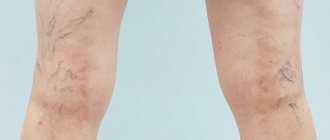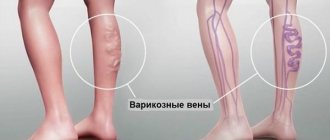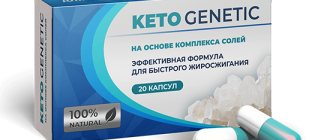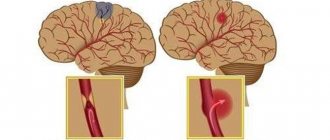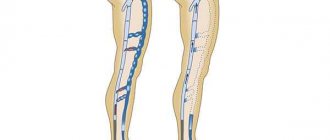Treatment of varicose veins without pain
Laser method - Guaranteed results
Fill out the form and get a 15% discount!
Laser treatment of varicose veins without surgery is the most high-tech, minimally invasive and effective method of surgical intervention for varicose veins.
The point of the intervention is the thermal effect of the laser beam through the light guide on the wall of the affected vein, which leads to recovery and cessation of the progression of varicose veins.
The effect of laser treatment manifests itself not only in the early stages of varicose veins, but even with the development of venous trophic ulcers. Laser surgery for varicose veins is performed through a puncture of the vessel with a needle under ultrasound scanning control. No cuts required. A special light guide is inserted into the varicose vein, after which a local anesthetic is injected around the light guide, and the light guide is connected to a laser device.
Then the light guide is attached to a special device for automatic extraction, light energy is supplied, which coagulates the varicose vein by acting on the vascular walls.
Pain relief during laser surgery for varicose veins using ITA technology - no pain, no bruises!
Unique anesthesia with a cooled solution using a pump is the latest pain relief technology for laser treatment of varicose veins. Ice tumescent anesthesia ITA (ice tumescent anesthesia) according to Professor Klein’s method allows not only to completely and permanently anesthetize the surgical area, but also to relieve the patient from extensive bruises that appear after the usual practice of anesthesia during EVLT. Cold and adrenaline cause vasospasm and reduce bleeding of the subcutaneous tissue. At the Innovative Vascular Center, this technology has been brought to perfection.
Endovenous laser coagulation is a minimally invasive procedure and does not require general anesthesia. For anesthesia, weak solutions of local anesthetics (novocaine or lidocaine) are used. Anesthesia begins with numbing the puncture site. This is the only place where the patient will feel pain. Direct treatment of varicose veins with a laser under tumescent anesthesia is absolutely painless.
After installing the light guide into the vein, the phlebologist performs a special infiltration (tumescent anesthesia). To do this, a large volume of a weak anesthetic solution is used, which is supplied around the vein using a special device - a hydropump. This results in a tight infiltration around the trunk of the saphenous vein, which not only anesthetizes the procedure, but also presses the varicose vein to the light guide, ensuring tight contact and removing blood from the laser impact area.
What is a laser?
Indeed, before answering questions about laser vein removal, you need to understand what a laser itself is.
Most of us know that this is a beam, but not everyone can answer how it differs from a regular light beam. The word “laser” is formed by adding the first letters of the words l ight amplification by stimulated e mission of r adiation - “amplification of light through stimulated emission. ” Thus, a laser is a beam of light, only greatly amplified. Due to its power, the laser can cut tissue during surgical operations, “seal” blood vessels, etc.
The source of the laser beam can be different substances: some crystals, gases, metal vapors, solutions, etc. This is the so-called “active medium” of the laser. In order for the laser beam to acquire the necessary strength, it must be “pumped with energy.” Therefore, there is a system in the laser, which is called the pumping system. The laser also has a system of mirrors that change the angle of the beam, and various filters.
Possible complications after EVLT
Treatment of varicose veins without surgery using laser does not require hospitalization, because it is a safe outpatient treatment method. In the first days after the procedure, thickening and redness of the skin are detected along the vein “sealed” with the laser, and bruising is possible. After a few days, the bruises resolve, but the induration may persist. One in 10 patients experiences a slight fever.
Traditional methods of dealing with bruises can speed up the recovery process. We offer patients vodka compresses and rubbing in Lyoton ointment, this allows you to quickly get rid of seals.
About 2-3 weeks after EVLT, you may experience slight tugging along the vein in your thigh, which, however, does not require pain relief. In the area of sclerotic varicose tributaries, coagulums can form, which completely resolve after 3-4 months and do not cause problems for patients.
Temporary changes in skin color (hyperpigmentation) during laser obliteration are quite rare and disappear without a trace after 2-4 months.
Thrombophlebitis of a laser-treated vein develops very rarely. To exclude this, an ultrasound scan of the surgical area must be performed in the near future after the intervention. If thrombophlebitis is detected, surgery under local anesthesia may be required - ligation of the mouth of the saphenous vein. Such problems occurred when using older types of lasers and optical fibers in a ratio of 1:1000 treatment cases. With the transition to a different wavelength and radial light guides, which make it possible to treat varicose veins at low energy, we stopped noticing this complication.
Deep vein thrombosis after laser treatment of varicose veins was not observed in our practice, but the literature describes isolated cases in patients with a congenital tendency to thrombosis (thrombophilia). Ways to prevent this complication include injections of low molecular weight heparins (Clexane, Fraxiparine) or oral tablets such as Xarelto.
We have not observed any dangerous complications in our practice, however, according to the literature, careless handling of the laser can result in burns to the skin and subcutaneous tissue. In experienced hands, the likelihood of these complications is negligible. To improve the quality of life after the intervention, long-term use of diosmin preparations (Detralex) helps.
Why is it recommended to use the laser obliteration method?
The essence of the EVLO technique is the thermal effect that laser radiation has on the inner wall of the vein. The peculiarity of laser energy is that it acts indirectly.
The main part of the energy is absorbed by the blood in the vessel, in which, under the influence of laser radiation, tiny vapor bubbles are formed. They transmit the thermal effect of the laser to the walls of the vessel. Heat damages the endothelium - the cells lining the vein from the inside, causing protein coagulation in them. Destruction of the endothelium provokes gluing of the walls of the vein, thus the vessel is, as it were, “welded” from the inside.
In this case, complete destruction of the endothelium is of particular importance. If viable areas of cells remain, they can subsequently regenerate, and blood flow in the laser-treated vessel can then be restored. Therefore, during laser ablation it is necessary to achieve complete destruction of the cells of the internal lining of the vein and at the same time not to burn through the vessel.
Fortunately, the latest generation of high-tech lasers have an optimal wavelength of 1.47 micrometers (µm) for intravascular obliteration. Such irradiation is almost completely absorbed by the aqueous part of the blood, turning it into steam, and treats the inner wall of the vein with optimal intensity. In this case, the likelihood of vessel perforation is practically absent, the postoperative period proceeds smoothly, without complications or pain.
Get an online consultation
right now.
Get
After laser treatment, the burn of the inner wall of the vessel triggers regeneration processes, which, in addition to the endothelium, also capture other layers of the venous wall. As a result, the lumen of the vein closes, and approximately a year after laser obliteration, the vein turns into a cord, a “cord” of connective tissue, and the external manifestations of varicose veins disappear.
The effectiveness of laser treatment for varicose veins
In all patients, within a month after endovenous treatment of varicose veins of the legs, it is possible to completely cure and eliminate varicose nodes. In our practice, we have not observed relapses of trophic ulcers after the laser treatment of varicose veins. There is no need for conservative treatment to eliminate the symptoms of venous insufficiency.
Early recanalization (restoration of the lumen) of the treated varicose vein is observed in 3% of patients within a year; repeated EVLT can completely cure the relapse without resorting to incisions. The absence of reappearance of varicose veins during the 5-year follow-up period was observed in 96% of patients. In case of an initial relapse, it is enough to conduct a session of foam sclerotherapy to prevent the progression of varicose veins.
Team of Doctors
Bruises may appear along the treated vein, which will disappear on their own after some time. Also, during the first week, pulling sensations along the limb, at the site of the treated vein, may be disturbing. This is a consequence of postoperative inflammation; discomfort can be alleviated by taking non-steroidal anti-inflammatory drugs prescribed by the doctor.
Some patients report discomfort associated with the sensation of a “cord” along the thigh, which is pulled when trying to fully extend the leg. This is a natural phenomenon associated with the overgrowing of the lumen of the vessel with connective tissue. Within a month and a half, such discomfort will completely disappear.
A moderate increase in temperature within a short time after the intervention is also normal. It is caused by the body’s reaction to protein breakdown products due to their coagulation. If necessary, you can take a fever-reducing drug, although in the vast majority of cases it is not necessary.
When not to do EVLO
- the presence of thrombophilia in the patient - in this case, the risk of thromboembolism significantly increases;
- chronic arterial ischemia of the tissues of the lower extremities - in the postoperative period, ischemia may intensify, which leads to adverse consequences;
- the impossibility of maintaining an active lifestyle for the patient after surgery, as this is required by the postoperative period;
- inflammatory process in the area of the upcoming surgical intervention - this can lead to the spread of infection during surgery and sepsis.
During the operation, our vascular surgeons make a small puncture of the skin, and all manipulations are carried out under the control of an ultrasound machine. In this regard, there are no terrible scars left on the patient’s skin after endovasal laser obliteration has been performed. Photos of the lower extremities of patients who have gone through this can be viewed on this page of our website.
Preoperative preparation
Before laser treatment, a preliminary consultation with a phlebologist is required with ultrasound duplex scanning of the venous system, with a minimum list of laboratory and instrumental research methods. It is necessary to inform your doctor in advance about taking medications, if any, as well as about possible allergic reactions to any drugs. On the day of the procedure, the patient should wear loose shoes and loose clothing.
EVLT and RFA are often talked about together. Is this the same procedure?
EVLT is the process of “sealing” a vein with a laser. RFA is radiofrequency vein ablation. Both procedures have the same principle: a thermal effect on the vein wall from the inside, so that after damage the walls “stick together.” During EVLT the impact is carried out with a laser beam, during RFA - with radio waves.
The difference between the two methods is in the nuances. For example, the treatment temperature during RFA is lower, but the device itself previously made it possible to treat the vein more evenly. Modern devices for EVLT and RFA provide the same accuracy of vein treatment.
How is the safety of any intervention determined?
The safety of any technique is determined by the number and danger of complications that may arise. As a rule, the younger the technology, the greater the possible risks and likely side effects when implementing it. The history of classical vein surgery goes back over a hundred years of use. The technology has been studied thoroughly. Moreover, even among recognized masters, complications such as lymphorrhea and the formation of rough hypertrophic and keloid scars are not uncommon. But most importantly, classical interventions require visualization through the surgical wound, which carries the following negative aspects:
- Not all veins requiring correction will be available for removal.
- Relapse rates for open surgery are always higher than for endovascular surgery.
- Significant surgical trauma.
